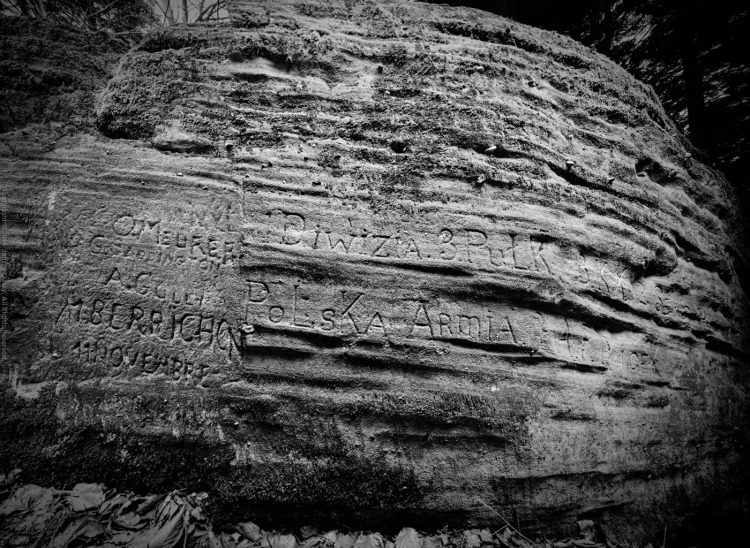Never-Before-Seen WWI Photos are Poignant Reminders of the Great War’s Centennial
In time for Veterans Day, carvings represent soldiers’ observance of three phases of the war and peace
DALLAS (Nov. 9, 2014)—In honor of Veterans Day, Dr. Jeff Gusky reveals two special new photographs from The Hidden World of WWI collection. The first is the only known surviving graffiti by Polish troops fighting with the Allies. On this boulder, soldiers from three different armies carved their names in stone at three different times during the war.
Americans manned this obscure part of the Western front in the Vosges Mountains during the summer of 1918. In October 1918, the area was turned over to the Polish army, and then on Nov. 11, 1918, now known as Veterans Day, the war ended and the French assumed control. In photo 1, American troops left their mark. Oscar Meurer, from New York City, proudly inscribed “NYC” next to his name. To the right, the Polish Army inscribed their unit number. And beneath the American soldier’s inscriptions is the name of a single French soldier who carved the date “11 Novembre” beneath his name.

 The simplicity of the second photo needs no explanation. It’s a clear, carved statement in celebration of PAIX, French for peace.
The simplicity of the second photo needs no explanation. It’s a clear, carved statement in celebration of PAIX, French for peace.
“In the thousand of images I captured underground, almost none of them were about war,” says Gusky. “The carvings and inscriptions are all about grief, love, spirituality, missing home, beauty and art. They are like messages in a bottle unopened until now that say, ‘I was here, I once existed. I was a living, breathing human being.’ And there are thousands of these names inscribed on the stone walls of former underground cities beneath the trenches of WWI that are a direct human link between then and now. We now can glimpse the soldiers’ humanity which remained intact despite the horrors of war.”
About The Hidden World of WWI
The Hidden World of WWI is a treasure trove of thousands of photographs of an underground world frozen in time nearly 100 years ago. There, in forgotten Medieval rock quarries, WWI soldiers created cities complete with electricity, rail systems, houses, churches, hospitals and art – inscriptions that capture how soldiers from different countries escaped intense trench warfare. You can find samples of the collection at www.JeffGusky.com. Follow The Hidden World of WWI on Facebook, Instagram and on Twitter where a new photograph will be revealed each day through 2019, the end of the WWI centenary.
About the artist
Jeffrey Gusky, M.D., FACEP, lives two lives — one as a rural emergency physician and the other as a fine-art photographer and explorer. He is a National Geographic and New York Times photographer.
Two books of black-and-white photography, multiple national exhibitions including the pairing of his work with the Spanish master Francisco de Goya and the legendary early 20th Century photographer Roman Vishniac, inclusion in a Broadway play and the honor of a Gusky traveling exhibition being ranked by Artnet Magazine on its 2009 list of the top 20 museum shows in America mark Jeff Gusky’s fine-art career. He explores the world — photographing pieces of the past that can help us discover how modern life affects our humanity and which inspire us to ask questions about the vulnerabilities of modern life that we have forgotten how to ask.
###
Press kit photos: http://jeffgusky.photoshelter.com/gallery/Press-Hand-Outs/G0000rVIDAQOWK9w, password: HIDDENWORLD
For more information, contact:
Karen Carrera, TrizCom, (m) 972.207.1935, karen@trizcom.com
Katie Hill, TrizCom, (o) 972-247-1369, katie@trizcom.com
